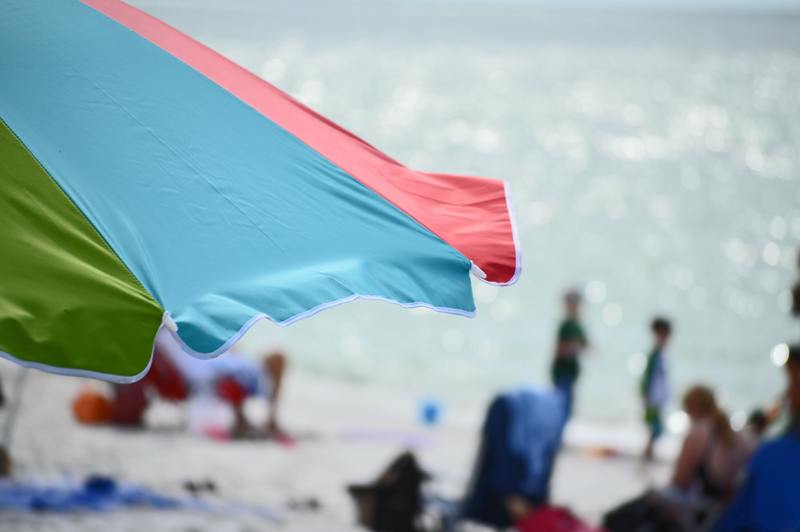You might be wondering how to clean outdoor umbrella with mildew after battling with heavy rain showers. No worries though because this guide can ease the crease on your forehead.

Treating Mildew-Infested Outdoor Umbrella
Mildew only needs moisture and humidity to grow in certain areas. An outdoor umbrella is no exception.
Step #1. Close the umbrella properly
Of course, you need to collapse the umbrella first as leaving it open might lead to more serious mildew issues. This will also be useful in the cleaning process itself.
When removing the mildew, it will make your life easier if the umbrella is properly closed. You surely do not want to tear the fabric as you prepare it for cleanup.
Step #2. Unhook the fabric
The next step is to determine where the umbrella attaches to its base. You’ll need to detach anywhere from four to ten prongs on most umbrellas.
Make sure the fabric is unhooked all the way around the umbrella.
Other points where the cloth joins to the base will be found on some umbrellas. Make a thorough inspection of the umbrella to ensure that nothing is connected.
It’s not something you want to rip!
Step #3. Shake off visible dirt
Brush out all excess dirt and debris from your outdoor umbrella before putting it in the washer. You don’t want that to go into your washer and cause long-term problems.
Step #4. Put it in a cold wash
Washing the umbrella is simple once it’s down and free of loose dirt. Simply put it in your machine with some detergent and a long cold wash cycle.
Bleach can be used if you have a white umbrella. It must, however, be totally white — not off white.
Bleach will destroy the color of your umbrella otherwise. When loading the outside umbrella into the washer, be careful not to get bleach on your clothes.
Step #5. Let it dry completely
It’s critical to let your outside umbrella air dry. Do not put it in the dryer; it will shrink and you will no longer be able to hang it outside.
It will dry in a few hours if you lay it under the sun.
If you have a dark-colored umbrella, the sun may fade some of the color. Allow it to dry in the shade overnight instead.
If such a solution did not work, you can also try an alternative method.
In a 5-gallon bucket, soak your outside umbrella in vinegar and dish soap or dish soap and water. Allow the cleaning solution to break down the mildew and difficult dirt on your umbrella by soaking it for 20 to 30 minutes.
The umbrella should next be air dried in the sun. If the mildew on your umbrella persists, you can dry it and soak it again.
Some umbrellas, on the other hand, refuse to come clean. If you leave your umbrella out throughout the winter or live in a region where the weather is unpredictable, it will become filthy and moldy.
The majority of dirt can be removed, however mold is a different matter. It’s possible that the effort you put into cleaning it isn’t worth it.
As a result, you might want to consider investing in a new outdoor umbrella. However, they are pricey. Before you give up hope, try cleaning it a few times.
Maintaining an outdoor umbrella
If you want to have the same problem in the near future, then you must face it head on by following some preventative measures.
While there are strong gusts or when the umbrella is not in use, don’t leave it open. Close the umbrella and tighten the strap across the centre, pressing the arms firmly against the umbrella mast.
When your umbrella is not in use, it is advised that you store it in a cover bag to keep the fabric and frame looking nice for as long as possible. Pollution, dust, salt spray, pollen, birds, wind, and excessive sun exposure all create wear and tear on the cloth.
This will significantly increase the umbrella fabric’s life while also reducing wear and tear on the frame. Thus, it is saving you from spending a fortune!
Especially in coastal areas, it’s a good idea to wash your umbrella with fresh water from a hose on a regular basis. This will aid in the removal of salt residue, filth, and the cleaning of the umbrella frame and cloth.
If necessary, wash the entire umbrella with warm soapy water to remove any dirt or grime that has accumulated. This will ensure that no remaining dirt has been left behind.
It might be also helpful for you to know what you are dealing with. This article on how fast does mildew grow might answer some of your questions.
If you or anyone in your household is immunocompromised and you have a mold-infested area, try knowing what is the most dangerous mold so you could get a heads up.
Conclusion
Whether it’s the rainy season or not, it would be better to take a mental note of these tips on how to clean outdoor umbrella with mildew. When rain comes pouring on your supposedly sunny day and leaves you with traces of mildew, you would not be as downtrodden as the others.
